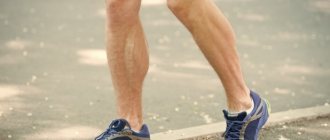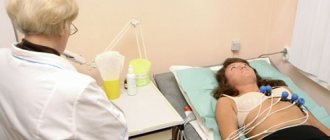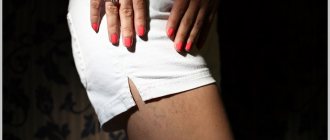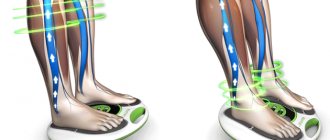The most important task of blood vessels is to provide nutrition and oxygen to all cells of the body. They carry blood from the heart to all cells, tissues and organs, and then return to it again.
By vessels we mean:
- capillaries;
- veins;
- arteries.
Capillaries are microscopic tube-like elements that branch a thousand times along the way from one organ to another. It is in the capillaries that the exchange of vital substances between cells and arterial blood occurs. The vessels also remove metabolic products and carbon dioxide from the body, which the tissues give back, receiving nutrition and oxygen in return. Even with the most minor circulatory disorders, disruptions occur that interfere with this process and diseases associated with impaired blood supply to the tissues and cells of the body develop. In this article we will try to competently answer the question of how to improve blood circulation in the legs.
Causes of the phenomenon
The causes that cause disruption of blood supply are divided into several groups:
- peripheral angiopathy (more often develops with diabetes mellitus, peripheral atherosclerosis);
- blockage of blood vessels in atherosclerotic diseases;
- inflammation of the artery walls, which leads to their spasm.
The above disorders provoke the following diseases:
- Atherosclerosis of the legs, which is called obliterating (a chronic disease characterized by numbness of the legs and lameness). The disease develops due to the accumulation of lipids and cholesterol plaques in the vessels, which lead to blockage of the capillaries (in whole or in part).
- Thromboangiitis obliterans (endarteritis). The disease is autoimmune in nature. It manifests itself in the fact that the spasmodic vessels of the thigh are poorly supplied with blood, as a result of circulatory disorders. The disease mainly affects young men who abuse nicotine.
- Vascular damage as a result of diabetes mellitus. The term “diabetic foot” is well known in medicine. As a result of poor circulation in the legs, gangrene (necrotic lesions of the foot) begins, which does not respond to conservative treatment. Typically, a diabetic foot results in amputation.
- Thrombophlebitis.
Signs of deterioration
The first symptoms of venous circulation disorders are mistaken for signs of fatigue. These include numbness in the fingers and tingling in the feet, heaviness and fatigue. Signs of deterioration of blood circulation in the extremities increase gradually:
- the skin feels cooler to the touch than the surrounding areas, vascular points first appear on it, and then veins begin to appear;
- itching and irritation appear;
- convulsions occur;
- The functioning of the hair follicles is disrupted - hair falls out.
Not everyone knows that poor blood circulation in the legs affects the general condition of the body. Spots appear on the skin not only in the problem area, but also on the hands, even on the face. Couperosis occurs, the person complains of constant fatigue and reluctance to move. Weakness increases even with light exertion, drowsiness occurs, nails often break and hair splits.
Attention ! If restoration of blood circulation in the legs does not begin at the first symptoms of deterioration, varicose veins develop first, and then thrombophlebitis. The risk of pulmonary embolism, strokes or heart attacks increases due to possible blood clots.
Symptoms of poor circulation
Poor blood supply to the legs is manifested by pain when walking, which disappears at rest. This symptom is a hallmark of diseases that indicate serious problems with the arteries. It's called intermittent claudication.
There are several factors that provoke the development of intermittent claudication:
- abuse of nicotine and alcohol;
- elderly age;
- lipid metabolism disorder;
- obesity;
- psycho - emotional stress;
- genetic predisposition;
- diabetes.
With this symptom the following are observed:
- pain in different parts of the leg: in the lower back, foot, knee or hip;
- numbness and chilliness of the limb;
- weakness in the legs;
- heaviness in the legs, a person has difficulty moving his legs;
- frequent seizures.
In some cases, atherosclerosis of the lower extremities does not manifest itself with any symptoms.
Lifestyle correction
Correction of habitual existence is the basis for normalizing blood supply to the legs, which can be restored due to the restoration of vascular tone. But this is not always enough.
First of all, you should give up smoking - a provocateur of toxic vascular paralysis with nicotine (according to statistics, without timely correction, necrosis of leg tissue with gangrene and amputation occurs in 100% of cases) and alcohol, which destroys the body, stenosis of blood vessels, causing ischemia of tissues and organs, the development of hypertension , atherosclerosis, thrombophlebitis, AMI, stroke (maximum alcoholic beverages/day - 30 grams per day, not on an ongoing basis).
In addition, you should minimize the intake of caffeine-containing drinks: systematic consumption of coffee and surrogates leads to vascular spasm and the risk of stroke or heart attack. It makes sense to replace coffee with chicory or other invigorating analogues.
Physical activity is equally important to improve blood flow in the lower extremities. This could be exercise therapy - a special set of physical exercises recommended by the doctor, swimming, walking, running.
Normalization of body weight is a condition without which stimulating blood flow in the legs is not only useless, but also dangerous: inadequate load on the vessels with excess weight leads to serious complications. We must not forget that excess weight is a consequence of lipid metabolism disorders, which is a priori a trigger for atherosclerosis with ischemia of leg tissues and trophic disorders.
A balanced diet is the background of the changes taking place in the body: you need to give up excess animal products in favor of plant components, make meals in fractions, correctly calculate the drinking regime (40 ml of clean water per 1 kg of weight).
Anyone who is associated with standing on their feet in a static position should think about changing their profession or correctly alternating statics and dynamics, since prolonged lack of movement and static load are the cause of the development of atherosclerosis, thrombosis, venous insufficiency and varicose veins. Half an hour of light exercise such as walking and leg swings is enough to improve blood flow in the legs and stimulate the functioning of the venous valves. Physical inactivity has the same consequences.
Psycho-emotional stress is closely related to physical activity: the release of adrenaline, cortisol, angiotensin into the blood provokes vasospasm, and an increase in blood pressure is no worse than lifting an unbearable load. In the long term, this means degeneration and destruction of blood vessels, impaired blood flow in the lower extremities, varicose veins and other troubles. Physical hyperload works almost the same way.
Uncomfortable shoes and tight clothing cause compression of the tissues of the lower extremities and impair the movement of blood through the vessels. Compression jersey, which can be mistaken by an amateur for items of clothing that correct blood flow, is indicated only for certain disorders; on the recommendation of a doctor, it is therapeutic and performs completely opposite functions than skinny jeans, for example.
Kinesitherapy - massage and exercise therapy - serve to improve blood circulation in the legs, the exercises are selected by the doctor, but you can also perform a number of actions yourself:
- walking in place for a minute;
- rotation of the ankles or knees clockwise and counterclockwise in a sitting position 10 times;
- alternate leg raises;
- chaotic shaking of the lower extremities.
Massage is carried out in a system, in courses. The essence is to relieve muscle strain, balance muscle tone and blood flow through artificial activation of venous valves.
Diagnosis of circulatory disorders
In order to take measures to improve blood supply, it is necessary to accurately diagnose such disorders.
For diagnosis, you should contact a vascular surgeon (angiosurgeon), who will prescribe a variety of instrumental studies:
- Doppler (Dopplerography) of blood vessels (ultrasound of blood vessels of the legs). The essence of the method lies in the ability of ultrasonic waves to penetrate tissue and be repelled from the surface of red blood cells, which are part of the blood and move with it. Doppler detects areas where blood is stagnant. In other words, if the mobility of these blood cells in certain areas is reduced, then a blood supply disorder is diagnosed.
- Angiography of leg vessels. It is an instrumental contrast study of capillaries, veins and arteries, which allows you to determine the condition of the walls of blood vessels, as well as the presence of barriers that prevent normal blood circulation.
- Thermometry (determination of skin temperature of the lower extremities).
- Contrast magnetic resonance imaging (MRI). In order to get better results, the MRI procedure is combined with the introduction of a contrast agent into the body. It is administered intravenously, which allows for better diagnosis.
- Capillaroscopy. A method that evaluates the condition of soft tissue capillaries. But this method can be used to determine the level of blood microcirculation.
How to improve blood circulation in the legs?
Poor blood circulation in the legs affects the functioning of the entire body. Therefore, this condition requires urgent correction. Poor blood supply is treated in two ways:
- Conservatively;
- Surgically.
In order not to resort to surgical intervention, it is necessary to begin conservative treatment in a timely manner. It consists of treatment using:
- physiotherapeutic procedures;
- pharmacological drugs;
- physical therapy;
- massage.
For successful treatment, you need to completely change your lifestyle and get rid of bad habits (alcohol and nicotine consumption, fatty foods, sedentary lifestyle).
Pharmacological treatment involves taking:
- antiplatelet agents (drugs that improve blood circulation);
- anticoagulants (drugs that prevent the formation of blood clots);
- statins (drugs that lower cholesterol);
- phlebotonics (drugs that improve vascular tone);
- diuretics (diuretics that relieve congestion in the legs).
In advanced cases (if you do not consult a doctor in a timely manner), there will be a need for surgical treatment, which is carried out in two directions:
- angioplasty;
- open surgery.
Angioplasty speaks for itself. This is a surgical procedure to replace a diseased vessel with the placement of a stent, a metal device that is implanted into the vessel to keep it open.
Open surgery is a full-fledged surgical operation that is performed to create an artificial vessel (shunt), bypassing the affected ones. To create such vessels, a donor artery is taken (from the patient’s own vessels) and bypass surgery is performed. The shunt can also be made of artificial material.
Proper nutrition
Proper nutrition will help improve blood circulation in the body, which should include foods containing vitamins, minerals, antioxidants, fiber, and bioflavonoids. All these substances improve not only blood circulation in the body and the condition of the circulatory system, but also the overall condition of the entire body.
Fruits and vegetables, berries, cereals, fish are foods that help improve circulation. But consuming fast food, alcohol, coffee, carbonated drinks, starchy and fatty foods, as well as foods high in sugar, worsens the condition of the cardiovascular system and blood flow in the body in particular.
Reducing the amount of fatty foods in your diet and correspondingly increasing your consumption of vegetables and fruits will reduce bad cholesterol and improve blood circulation. It is better to replace animal fats with fats found in flax seeds, nuts, and olive oil.
Don't forget to drink enough water. It is recommended to drink at least 1 liter of water daily.
To strengthen the veins, it is recommended to consume foods containing procyanides (cranberries, blackberries, dark chocolate, grapes, blueberries and red wine) and rutin (citruses, apricots, cherries, pomegranates, black tea), which also reduces swelling of the veins.
Regular seasonings and spices will improve the condition of the circulatory system. Garlic, chili pepper, ginger, oregano, turmeric, rosemary, cloves, cinnamon, dill, coriander, thyme are natural remedies that stimulate blood circulation in the body.
Therapeutic exercises for circulatory problems in the legs
Well-being will improve completely only when a person begins to perform moderate physical exercise. To do this, it is not necessary to visit fitness centers or gyms. Short walks, swimming, hiking, cycling, dancing and yoga will help improve blood circulation. When performing special exercises to correct blood supply, it is necessary to select those that are suitable for a person according to his illness and well-being. In addition, it should be remembered that there are activities that are strictly contraindicated for people with impaired blood circulation in the legs. These include:
- mountaineering;
- weightlifting (lifting weights);
- athletics (all types).
Otherwise, serious complications may arise that will require surgical treatment. Why is it so important to restore normal blood circulation in the lower extremities in a short time? Thanks to high-quality blood supply to the lower extremities, the tissues are enriched with nutrients and get rid of metabolic end products, which contributes to the health and strengthening of the legs. Unfortunately, diseases that provoke blood circulation disorders in the lower extremities have a chronic course and cannot be completely eliminated. In this case, the best effect that can be achieved is stopping the progression of the disease.
Treatment
If treatment is not started in time, non-stenotic atherosclerosis of the legs can easily develop into a more severe stenotic phase of the disease, characterized by swelling and tissue atrophy, blockage of veins, and, as a result, gangrene.
Even when the lumen of the vessel is completely closed by cholesterol deposits, blood still circulates through collateral branches, so the symptomatic picture may not be clear.
Medicines
The treatment regimen largely depends on the severity of vascular damage, the duration of the disease and the stage at which it is at the time of treatment, as well as the presence of concomitant pathologies.
What medications are used to treat the lower extremities when normal blood circulation in them is disrupted? List of drugs:
- Antiplatelet drugs for the prevention of vascular blockage and their treatment, such as Aspirin, Reopoliglyukin.
- Vascular drugs with dilating action, for example, Vazonit, Vazaprostan, Trenal and others.
- Medicines that increase physical endurance - Pentoxifylline and Cilostazol, which improve blood circulation and make walking easier for the patient.
- Drugs that reduce the content of “bad” cholesterol in the blood.
- Anticoagulants that thin the blood, such as Warfarin, Heparin.
- Antispasmodics, for example, Drotaverine. Neutralize vascular spasm, reduce pain.
- Drugs that increase blood circulation in tissues, this can be Zincteral and others.
- Diabetics are prescribed fibrates to reduce the amount of triglycerides, such drugs as Bezafibrate, Clofibrate.
- To regulate cholesterol levels, statins are prescribed: Lovastatin, etc.
- An ointment made on the basis of antibacterial agents (Levomekol, Dimexide) treats trophic ulcers on the legs.
- Vitamin complexes.
- A nicotinic acid.
- Physical procedures, for example, electrophoresis and others as prescribed by the doctor.
American scientists have proposed introducing the prevention of atherosclerosis with aspirin and β-blockers to all people who have reached the age of 45. Such measures, according to foreign doctors, are necessary even if there are no obvious signs of atherosclerosis.
ethnoscience
The disease can be cured with herbal remedies only at the very beginning of its development. In all other cases, taking natural drugs should be carried out in combination with the main drug treatment as an auxiliary means. The use of any medicinal substance from the arsenal of traditional medicine must be agreed with the attending physician and not contradict the main treatment.
Several folk recipes:
- To restore blood supply to the legs, you can use the following treatment option. It is necessary to collect pine needles, preferably from first year branches, but this is possible. Grind the raw materials, pour into a 3 liter pan, and fill more than half of the container. Pour boiling water over everything. After 2 hours, pour the water into a separate bowl, pour boiling water over the needles again and cook for five minutes. Filter the broth and combine with the previously prepared infusion. Take 1/4 cup of the medicinal solution, adding honey to it, twenty minutes before meals. You need to drink this remedy for a long time, more than one month. The first results will appear in three weeks.
- Ordinary cucumbers from your home garden will help get rid of blood clots in the peripheral vessels of your legs. When the vegetable begins to ripen, it is necessary to collect it and grate it or chop it in another way, for example, in a blender. Then squeeze out the juice. Do this every day, drinking 3-4 glasses on an empty stomach. Continue treatment throughout the cucumber season, until it ends.
- Another plant from our garden has an antiplatelet effect. Dry the carrot tops so that there is enough for the whole year. During the season, you can use fresh herbs to prepare a decoction. Boil a handful of tops in a liter saucepan for no more than five minutes. Then you need to wrap everything up and leave for about an hour, then filter and drink 150 ml of the decoction, which should be done half an hour before meals.
- It is very useful to drink a mixture of juices on an empty stomach with honey added to them: apple-carrot, beet-carrot, carrot-celery and carrot-garlic. Drink three-quarters of a glass of juice three times a day.
- Vascular pathologies of the legs respond well to treatment with various beekeeping products: propolis, royal jelly, honey, the intake of which is combined with bee stings, as well as appropriate herbal remedies.
Massage, acupuncture
To restore normal functioning of the legs, doctors recommend massage and rubbing. Such procedures are carried out using a special ointment that penetrates deep into the skin of the extremities and helps relieve inflammation, swelling and pain, and improve poor blood circulation in the vessels of the legs.
The massage should begin with the foot, gradually moving to the lower leg and thigh. At first the movements are calm, then they become more intense, gradually stroking is replaced by kneading. During the day, you need to massage the sore limbs about five times. The duration of one session is about ten minutes. This simple system of massage and rubbing allows one to achieve significant success in treating the disease.
Video tutorial on foot massage:
Treatment of atherosclerosis can be carried out using oriental medicine, for example, acupuncture. This method allows you to quite successfully activate blood circulation in the relevant organs. In this case, the body is not exposed to various chemicals, as with drug treatment.
Physical exercise
Exercise therapy also helps improve poor blood flow in the legs. The load at the beginning of classes, as a rule, should be moderate, the pace of exercise should be comfortable for the patient. The basis of the treatment complex is the performance of exercises that involve the legs, the swings of which must be performed with a large amplitude.
Japanese healers suggest performing the following exercise. It is necessary to choose a suitable place where you can lie on your back, and the surface should not be soft. Place something under the neck area. Then raise your arms and legs. The feet should be up and parallel to the floor. You need to shake all your limbs for three minutes. The therapeutic effect on capillaries occurs due to vibration.
Alternating walking on toes and heels is very beneficial for the blood vessels of the legs. This exercise stimulates the blood to move more intensely.
By doing squats, you can strengthen the muscle tissue of your entire leg. In this case, it is necessary to ensure that the foot is “glued” to the floor.
Video lesson with exercises to improve blood circulation:
Proper nutrition
One of the means to combat the disease is proper nutrition. For a diabetic, this is doubly important. Considering the GI of foods, a diabetic patient should monitor blood glycemic indicators so as not to provoke the emergence of new complications.
The diet is designed in such a way that there is a gradual reduction in the patient’s diet of animal fats, simple carbohydrates, salt, and stimulants.
Cabbage is a very useful product for this disease. It removes excess cholesterol and saturates the body with plenty of vitamin C.
By using all the methods and means to improve blood circulation in combination, you can quickly achieve results and gain good health, and with it a better quality life full of positive aspects.
Exercises to improve blood circulation in the legs
Since the most effective and simplest way to normalize blood circulation in the legs is physical therapy, they should be started immediately after the problem is discovered. Moderate exercise is encouraged even if the patient has diabetes. These exercises can be done at home as they are simple and very easy to do.
The following exercises improve blood circulation and appearance of the legs:
- Slowly rise and fall on your toes, while feeling the tension in each leg muscle.
- Take turns lifting your legs off the floor, while performing circular movements with your feet.
- Exercise scissors. Lie on the floor, lift both legs up, then cross your straight legs in a scissoring motion.
- Exercise bike. Lie on the floor, bend your knees, and make movements simulating pedaling a bicycle.
- Exercise “Birch tree”. Lying on the floor, raise your legs up, perpendicular to the floor and bend them to your chin. Place your hands on your back slightly above your waist. The entire weight of the body should rest on the arms and shoulder blades. Stay in this position for a few seconds, and then carefully lie down on the floor.
All exercises must be repeated 5-10 times. Roller skating and ice skating are very useful, provided that the person has such skills. If you learn this specifically, you can get injured, which is not at all conducive to the health of your legs. You need to move as much as possible, take frequent walks, climb stairs on your own without an elevator, and try to avoid public transport.
Prevention
Diseases that lead to impaired blood supply to the legs are usually chronic. This means that the problem can be solved only if the complex of root causes that provoked it is eliminated. To prevent illness, you need to spend time on prevention. It does not require much effort, but will keep the circulatory system healthy.
Bad habits
Smoking drugs and tobacco (including passive smoking) can impair blood circulation in the lower extremities. Substances that make up smoke affect the venous walls and narrow the venous lumen. Drinking alcohol (including low-alcohol drinks) also has a negative impact on health. Alcohol reduces the elasticity of venous walls and disrupts lipid metabolism. It also causes plaque to clog the arteries.
Nutrition
Speaking about what to do if there is poor blood circulation in the legs, we should note the importance of proper nutrition. The basis of the diet should be plant foods, which include fiber, vitamins and minerals. Fruits, vegetables, cereals, dairy products and nuts will strengthen blood vessels and also increase their elasticity. At the same time, it is important to reduce the consumption of protein and fatty foods, sweets, flour, spicy, salty, smoked and fried foods.
Coffee and tea stimulate the appetite, promoting energy release. After this, the body needs compensation and begins to require large portions of high-calorie food. If the situation repeats regularly, sooner or later it will lead to problems with blood circulation in the extremities. And vice versa - drinking large amounts of water, fresh juices and compotes fills the body with fluid and restores blood circulation.
Attention! If you replace sugar with honey or stevia (sweet herb), you can very quickly feel an improvement in your well-being and a decrease in the intensity of unpleasant symptoms.
Physical activity
Moderate physical activity is one of the best ways to stimulate microcirculation in the limbs. Therefore, experts advise those who lead a sedentary lifestyle to get to work on foot or by bicycle. Just an hour of walking a day is enough to get the blood flowing in your legs. Initially, walking will cause discomfort, so during this period it is important not to abandon what you started. Having overcome yourself, you will soon be able to make sure that your efforts were not wasted.
In addition to walking, the circulatory system can be benefited by working in the country, cycling, rollerblading and swimming. Going to the bathhouse and sauna is also a means of preventing diseases of the circulatory system. Bath procedures improve blood circulation and strengthen venous walls. If you lose excess weight, your condition will improve even faster. Losing weight will relieve stress not only on the joints, but also on the heart and veins.
Stress
Not only do stress itself disrupt the functioning of the body, but it also entails many negative consequences in the form of insomnia, smoking, drinking alcohol, and “eating.” As a result, the functioning of the circulatory system is disrupted. Of course, you won’t be able to completely protect yourself from stress, so it would be more advisable to learn how to cope with this problem. To do this, you can read books on psychology, go to see a psychologist, do yoga, listen to soothing music, resort to aromatherapy, go for a massage, etc. Everyone must decide for themselves what to do.
Useful habits
To improve blood circulation in your legs, it is useful to develop healthy habits. Among these:
- wearing comfortable shoes;
- refusal of tight, tight clothing (for varicose veins, on the contrary, it is necessary to use compression hosiery, which exerts measured pressure on the venous walls);
- positioning the limbs during sleep at a level just above the heart (this is especially useful for varicose veins);
- frequent changes in body position when sitting for a long time.











